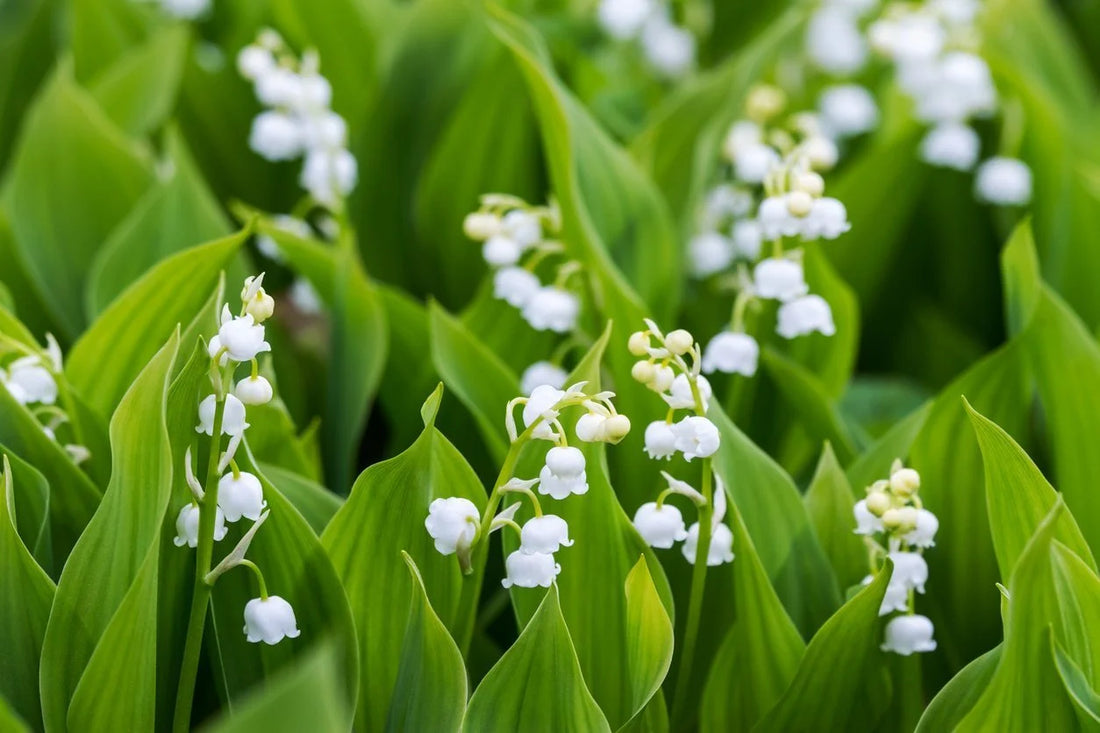
August: Lily of the Valley
When first researching this plant, I asked my customers what stories they have associated with Lily of the Valley. I heard childhood stories of planting them to attract fairies, while others angrily pull them up because they invade gardens so quickly.

What's in a Name?
Lily of the Valley is scientifically known as Convallaria majalis and is not a lily! It is classified in the Asparagaceae family which, as you might guess, includes asparagus. In Latin, majalis or maialis, means "of or belonging to May," while convallis means “valley”.
This plant goes by a plethora of names: May Lily, May Bells, Lily Constancy, Ladder-to-Heaven, Apollinaris, Glovewort, and Muguet. Depending on where in the world you are, these flowers hold a vast array of stories and lore.
Lily of the Valley Around the World
In the language of flowers, Lily of the Valley means a return of happiness, purity of heart, sweetness, humility, happiness, and love’s good fortune. As a May flower, this return of hope and love fits perfectly with the flower’s physical lifecycle.
One legend of the lily of the valley is that when Eve was forced to leave the Garden of Eden, her tears hit the ground and from them sprang these flowers. Some say that this plant blooms on the grave of someone who was executed for a crime they did not commit as a symbol of false justice and mourning. It is thought that planting them in a garden will protect the home from ghosts and evil spirits, and the flower is mentioned in fairy rings and gardens as it resembles fairy skirts or small cups to drink from. Its been used as a charm against witches’ spells, and is associated with the goddess of spring, Ostara, symbolizing new life to Pagans.

Although some people think it’s bad luck to pick or bring this flower indoors some parts of France trade Lily of the Valley on La Fête du Muguet or May Day to celebrate good luck for the year.
It’s a popular bridal flower and has a history in European wedding ceremonies adorning Queen Victoria, Princess Astrid of Sweden, and Kate Middleton in their wedding bouquets.
Following its ceremonial history, newlyweds in Holland plant Lily of the Valley in their gardens to symbolize their love and happiness.
Medicinal Properties

Every part of the lily of the valley plant, from root to flower, is toxic. That was an incredibly surprising fact to me as I’ve grown up seeing these flowers all through New England’s Spring.
Contact with the skin can cause some people to develop rashes, blisters, and swelling; and any sort of ingestion is poisonous. That being said, Lily of the valley contains the compound, convallatoxin, which can be used to help treat certain heart problems in small doses.
The roots of the plant contain the most poison, but often a trip to the hospital is the result of eating their tomato-like red berries.
It’s a beautiful dichotomy to have a dainty flower associated with happiness and purity also be poisonous upon any contact.
Cultivation
Though this plant is poisonous, it’s a very popular ground cover plant as it thrives in shady conditions and spreads quickly through rhizomes. Lily of the Valley is native to Asia and Europe and is now invasive in North American temperate forests.
Lily of the Valley is very hardy and can live for decades but cannot handle heat - perhaps we’ll see a change in their numbers as the Earth’s climate shifts.
This hardy plant rarely is affected by diseases and pests and seems to proliferate in conditions most others cannot - a wonderful symbol in it’s association with life and growth.
|
Thank you for joining us to learn about Lily of the Valley! Curious to learn more? Checkout these sources! https://worldoffloweringplants.com/legends-facts-lily-valley/ https://www.petalrepublic.com/lily-of-the-valley-flower-meaning/ https://www.webmd.com/first-aid/lily-of-the-valley-poisoning |